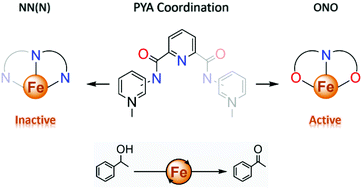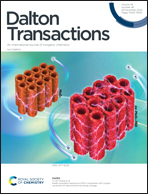Modular O- vs. N-coordination of pyridylidene amide ligands to iron determines activity in alcohol oxidation catalysis†
Abstract
A family of polydentate pyridine-substituted pyridylidene amide (PYA) complexes bound to iron(II) was developed. The variation of the coordination set from NN-bidentate PYA to tridentate pincer-type pyPYA2 systems (pyPYA2 = 2,6-bis(PYA)pyridine) had a large influence on the binding mode to iron(II), including a change from the N- to rare O-coordination of the PYA site and a concomitant shift of the predominant ligand resonance structure. These binding mode variations invoke changes in the reactivity of the complexes, which were probed in the peroxide-mediated oxidation of 1-phenylethanol to acetophenone. A comparison with uncomplexed FeCl2 indicated that bidentate NN coordination is unstable and presumably leads to the dissociation of FeCl2. In contrast, the tridentate ligand binding is robust. Remarkably, the tridentate PYA pincer coordination inhibits catalytic activity in the NNN binding mode, while the ONO coordination greatly enhances catalytic performance. Under optimized conditions, the bis-ligated ONO pincer iron complex [Fe(pyPYA2)2][2PF6] reaches full conversion within one hour (0.5 mol% catalyst loading) and under dilute conditions turnover numbers over 20 000 (0.005 mol% catalyst loading).



 Please wait while we load your content...
Please wait while we load your content...